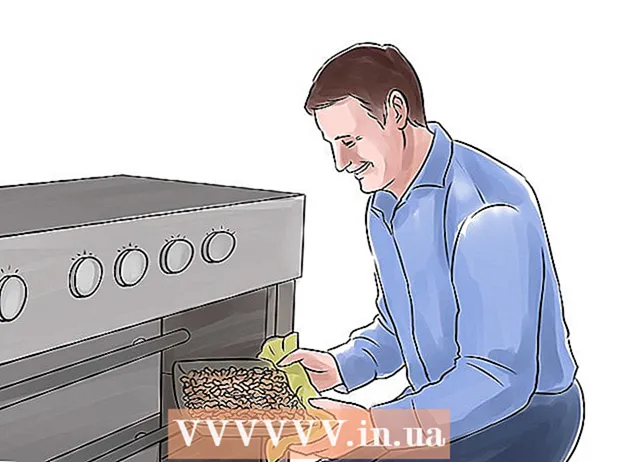Author:
Clyde Lopez
Date Of Creation:
22 June 2021
Update Date:
1 July 2024

Content
1 Level the ground (if necessary) and dig in support posts to support the shed. The supports will allow you to support the logs under the barn floor. In the design example, the supports are spaced 1800 mm from each other in one direction and 1200 mm from each other in the other, the total area of the support grid is 3600 x 2400 mm. It is convenient to cover the floor exactly three standard (1200 mm by 2400 mm) plywood sheets are required.- Please note that in some countries you must obtain a permit before doing land construction work.If you don't want to go deeper into the ground, replace the support posts with specially treated timber beams (to withstand contact with the ground) or flat-laid concrete fence posts.
 2 Attach the supporting longitudinal beams to the support posts. These beams will support the floor joists. The simplest way to attach beams to foundation posts is to use metal perforated plates. The example shows beams with dimensions 100 * 150 mm, having a length of 3600 mm.
2 Attach the supporting longitudinal beams to the support posts. These beams will support the floor joists. The simplest way to attach beams to foundation posts is to use metal perforated plates. The example shows beams with dimensions 100 * 150 mm, having a length of 3600 mm. - First attach the sheathing boards to the support beams along the outer edge of the support beams, they should be the same length as the beams.

- Logs should have a length corresponding to the width of the barn. In the example, the distance between the logs is 368 mm, with the exception of the two extreme logs, which are 349 mm apart from the neighboring ones, so that a standard plywood sheet overlaps half the width of the log, and the adjacent sheet overlaps the other half, so that the edges of the sheets are properly supported.

- To prevent the joists from moving, place spacers between the joists along the middle longitudinal bar.

 4 Nail the plywood sheets to the joists to form the floor. If necessary, use H-clips in addition to nails. They hold two sheets of plywood together for added structural strength. In the example design, two standard sheets (1200mm by 2400mm) of plywood are used in their entirety, the third is cut in half and used to fill the difference of 1200mm at both ends. Due to the correct distances between posts, longitudinal beams and joists, no additional plywood cuts are required. Note that the pieces of plywood are deliberately offset so that the floor does not have a single seam across the full width so as not to weaken the structure.
4 Nail the plywood sheets to the joists to form the floor. If necessary, use H-clips in addition to nails. They hold two sheets of plywood together for added structural strength. In the example design, two standard sheets (1200mm by 2400mm) of plywood are used in their entirety, the third is cut in half and used to fill the difference of 1200mm at both ends. Due to the correct distances between posts, longitudinal beams and joists, no additional plywood cuts are required. Note that the pieces of plywood are deliberately offset so that the floor does not have a single seam across the full width so as not to weaken the structure. - The floors can also be screwed to the joists with 70 mm screws.
- Rear wall frame construction... Make the bottom and top joists the same length for the floor they will be mounted on. Make the spacing between the uprights the same as the spacing between the floor joists. Note that the back wall must be lower than the front wall to allow water drainage.

- Front wall frame construction... The front frame should be the same as the back frame, except for the height and doorway in which you will place the door.

- Construction of frames for side walls... The length of the bottom beam of the side walls should be equal to the distance between the bottom rails of the front and rear walls (so that the side wall fits between them). The standard distance between vertical posts is 400 mm (the distance is measured from the center of the beams, not from the edges), if the distances between the posts are not divisible by 400 mm, the outer posts move closer to their neighbors. Most importantly, the top beam is angled so that the roof slopes, so the height of each upright will be slightly different. If you are not sure that you can correctly calculate the required height of each vertical post in advance, then first make the two outermost vertical posts, place them at the correct distance from each other, cut the upper beam in place, then measure the remaining vertical posts individually, based on the distance between top and bottom struts and their exact location.

- Bring four walls together. Usually wall structures are nailed to the base from the bottom up.However, if this is not possible, you can simply nail them to the base through the plywood, guiding the nails at an angle. Note that you will probably need people to help you hold the wall frames until they are connected to each other.
 6 Make roof rafters and separate them with sticks. The rafters should protrude from the walls of your barn for improved weather protection. Your measurements will be greatly simplified if you place the rafters in the same way as you placed the floor joists. When you're done, insert and secure spacer bars between each pair of rafters.
6 Make roof rafters and separate them with sticks. The rafters should protrude from the walls of your barn for improved weather protection. Your measurements will be greatly simplified if you place the rafters in the same way as you placed the floor joists. When you're done, insert and secure spacer bars between each pair of rafters.  7 Nail the plywood sheets to the rafters. If you added an overhang, then you need to make the appropriate changes to the cutting of plywood.
7 Nail the plywood sheets to the rafters. If you added an overhang, then you need to make the appropriate changes to the cutting of plywood.  8 Close the walls. You can use siding, textured plywood, or anything else to give the barn a finished look.
8 Close the walls. You can use siding, textured plywood, or anything else to give the barn a finished look.  9 Cover the roof with roofing felt. Start at the bottom of the roof slope and work your way up, each new level of roofing material should overlap the previous one, so that rain does not seep through the joints. You can also use shingles or other roofing material if you wish.
9 Cover the roof with roofing felt. Start at the bottom of the roof slope and work your way up, each new level of roofing material should overlap the previous one, so that rain does not seep through the joints. You can also use shingles or other roofing material if you wish. Method 1 of 1: Drawings (1 '= 30 cm, 1 "= 2.54 cm)
Tips
- If you are planning to do interior decoration, you must add an extra rack at each corner to be able to secure the finishing material.
- If instead of a ladder to enter the barn, you make a ramp, it will be easier for you to move equipment on wheels.
- You can cover the roof with cellular polycarbonate for natural light.
- Click on the images above to enlarge the picture.
What do you need
- Pillars
- Nails 70 mm
- Nails 35 mm
- Beam 100 * 150 mm for longitudinal beams
- Bar 50 * 150 for lag
- Beam 100 * 100 for the bases of wall frames
- Plywood 12 mm
- Textured plywood or wall siding
- Roofing material
Warnings
- Don't nail your finger!
- Check with your local building department for the amount of space required from your site.
- Before starting construction, find out what permits you will need to obtain.
- Check the zoning in your area to see if you can build a barn.



